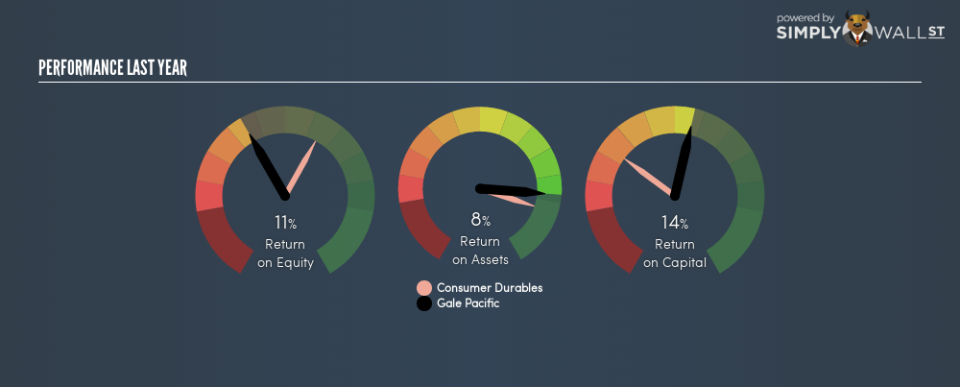Gale Pacific Limited (ASX:GAP) Might Not Be A Great Investment

Today we are going to look at Gale Pacific Limited (ASX:GAP) to see whether it might be an attractive investment prospect. In particular, we’ll consider its Return On Capital Employed (ROCE), as that can give us insight into how profitably the company is able to employ capital in its business.
First, we’ll go over how we calculate ROCE. Second, we’ll look at its ROCE compared to similar companies. Finally, we’ll look at how its current liabilities affect its ROCE.
Return On Capital Employed (ROCE): What is it?
ROCE is a metric for evaluating how much pre-tax income (in percentage terms) a company earns on the capital invested in its business. In general, businesses with a higher ROCE are usually better quality. In brief, it is a useful tool, but it is not without drawbacks. Author Edwin Whiting says to be careful when comparing the ROCE of different businesses, since ‘No two businesses are exactly alike.’
How Do You Calculate Return On Capital Employed?
The formula for calculating the return on capital employed is:
Return on Capital Employed = Earnings Before Interest and Tax (EBIT) ÷ (Total Assets – Current Liabilities)
Or for Gale Pacific:
0.14 = AU$14m ÷ (AU$145m – AU$42m) (Based on the trailing twelve months to June 2018.)
So, Gale Pacific has an ROCE of 14%.
View our latest analysis for Gale Pacific
Is Gale Pacific’s ROCE Good?
ROCE can be useful when making comparisons, such as between similar companies. In this analysis, Gale Pacific’s ROCE appears meaningfully below the 26% average reported by the Consumer Durables industry. This performance is not ideal, as it suggests the company may not be deploying its capital as effectively as some competitors. Regardless of where Gale Pacific sits next to its industry, its ROCE in absolute terms appears satisfactory, and this company could be worth a closer look.
Our data shows that Gale Pacific currently has an ROCE of 14%, compared to its ROCE of 5.6% 3 years ago. This makes us wonder if the company is improving.
When considering ROCE, bear in mind that it reflects the past and does not necessarily predict the future. ROCE can be misleading for companies in cyclical industries, with returns looking impressive during the boom times, but very weak during the busts. This is because ROCE only looks at one year, instead of considering returns across a whole cycle. What happens in the future is pretty important for investors, so we have prepared a free report on analyst forecasts for Gale Pacific.
What Are Current Liabilities, And How Do They Affect Gale Pacific’s ROCE?
Liabilities, such as supplier bills and bank overdrafts, are referred to as current liabilities if they need to be paid within 12 months. The ROCE equation subtracts current liabilities from capital employed, so a company with a lot of current liabilities appears to have less capital employed, and a higher ROCE than otherwise. To counter this, investors can check if a company has high current liabilities relative to total assets.
Gale Pacific has total assets of AU$145m and current liabilities of AU$42m. Therefore its current liabilities are equivalent to approximately 29% of its total assets. Low current liabilities are not boosting the ROCE too much.
Our Take On Gale Pacific’s ROCE
Overall, Gale Pacific has a decent ROCE and could be worthy of further research. Of course, you might find a fantastic investment by looking at a few good candidates. So take a peek at this free list of companies with modest (or no) debt, trading on a P/E below 20.
If you like to buy stocks alongside management, then you might just love this free list of companies. (Hint: insiders have been buying them).
To help readers see past the short term volatility of the financial market, we aim to bring you a long-term focused research analysis purely driven by fundamental data. Note that our analysis does not factor in the latest price-sensitive company announcements.
The author is an independent contributor and at the time of publication had no position in the stocks mentioned. For errors that warrant correction please contact the editor at editorial-team@simplywallst.com.

 Yahoo Finance
Yahoo Finance 
